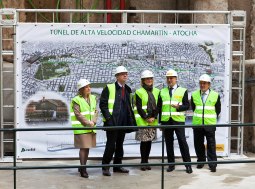FCC completes the drilling of the Atocha-Chamartín high-speed tunnel
The Minister of Public Works, José Blanco, together with the president of the Community of Madrid, Esperanza Aguirre, and the mayor of the capital, Alberto Ruiz Gallardón, accompanied by Baldomero Falcones, Chairman of FCC, José Mayor, Chairman of FCC Construcción, and Avelino Acero, General Director of the construction company, attended, on Friday, February 11, 2011, the conclusion of the excavation works for the AVE tunnel between the Atocha and Chamartín stations.

The Minister of Public Works, José Blanco, together with the president of the Community of Madrid, Esperanza Aguirre, and the mayor of the capital, Alberto Ruiz Gallardón, accompanied by Baldomero Falcones, Chairman of FCC, José Mayor, Chairman of FCC Construcción, and Avelino Acero, General Director of the construction company, attended, on Friday, February 11, 2011, the conclusion of the excavation works for the AVE tunnel between the Atocha and Chamartín stations, which is being built by FCC, in joint venture, by an amount of 206 million euros.
The assistants have visited the area where the extraction shaft of the tunnel boring machine used for the excavation is located, in front of the historic canopy of Puerta de Atocha.
This tunnel makes it possible to articulate the railway connection with origin or destination in the southern and eastern half of Spain, with the lines of the northern half. The section has been built on a double international gauge track, and has a total length of 7.3 km, of which 6.9 run underground, which facilitates its urban integration, as it crosses densely urbanized areas. It passes over Line 9 of the Madrid Metro, under eight other metro lines, and under the Iberian-gauge Atocha-Recoletos-Chamartín and Atocha-Sol-Chamartín tunnels, which serve commuter trains and long haul, at an average depth of 45 m.
Most of the tunnel has been excavated with a tunnel boring machine, except for a section next to the Chamartín station, 110 m long, which has been executed in the open. The excavation has been completed normally in just nine months, a period shorter than initially planned. During this period, the average daily progress has reached 25 meters, although in some days yields of over 57 meters were reached, achieving a cumulative in 31 days of 1,167.6 meters of tunnel excavation and lining.
The tunnel has been lined with 1.8 x 0.36 m voussoirs, assembled by the same TBM, and has eight emergency exits.
As an extension of the new high-speed tunnel, another tunnel is being built that will act as a bypass for the Atocha through station.
The underground AVE connection starts from Chamartín and runs under the Plaza de la República Argentina and the axis of Serrano and Alfonso XII streets, to then cross the Botanical Garden until it ends at the Emperador Carlos V roundabout, in front of the old canopy of the Atocha station.
In the coming months, part of the section will be filled up to the final level and the tracks will be installed inside the tunnel, in addition to the security and civil protection installations. The forecast is that everything will be ready by the end of 2012.
Safety has had the highest priority in the execution of the works. In this sense, the project has had exhaustive previous reports on the ground conditions and all the buildings near the tunnel route were inspected prior to the start of the excavation.
This railway connection between the Atocha and Chamartín stations, the construction of which has generated more than 5,000 jobs, will constitute an essential infrastructure for the development of an international-gauge backbone network in Spain.
FCC's experience in railway infrastructures
The FCC Group has a multitude of references for railway works of various types. Among the most recent, it is worth mentioning the sections of high-speed lines, from Madrid-Levante, in which the world record for progress with a tunnel boring machine has been broken up to five times in the Siete Aguas Buñol section, setting the world record at 83 .2 m excavated and 52 concrete rings placed in a single day; the Pajares variant on the León Asturias line, with the construction of the Pajares tunnel, over 25 kilometers long, and the Guadarrama high-speed access tunnels in northwest Spain, over 28 km long.
In the urban area, the Puerta del Sol Station-Gran Vía section, which consists of a colossal cavern with 240 m long platforms. long, at a depth of 30 to 40 m.
Outside Spain, it participates in the Faido and Bodio sections of the railway infrastructure of the Gotthard base tunnel, the longest in the world, in Switzerland; the rail link to the Berlin-Brandenburg airport and the rail access to the Vidin-Calafat bridge in Bulgaria.








